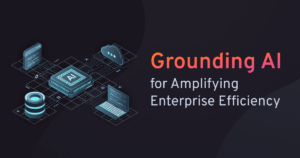The rapidly advancing Generative AI landscape is a vast reservoir of potential that modern enterprises are tapping into to glean unparalleled levels of efficiency and productivity. Among the large number of solutions being explored today is the groundbreaking concept of Grounding in AI.
Principally, this technique aims at integrating industry and organization-specific knowledge into base language models (also known as general language models), thereby magnifying both their understanding and prowess in accurately decoding unique phrases and, terminologies, and generating answers that are anchored to verifiable and approved sources of relevant documents and information.
AI Grounding increases enterprise efficiency by fine-tuning LLMs for a specific domain. Let’s dive into its intricacies—what it entails, its derivatives, and the mechanics of AI grounding within an enterprise framework.
Decoding LLM Grounding
In their training phase, base language models learn from a large mix of text data, mostly from the internet. It’s like a comprehensive lesson plan that teaches large language models (LLMs). But even with this wide-ranging learning, base models might struggle with some finer aspects, like industry and organization-specific details and reasoning. They may also have a hard time understanding organization-specific jargon, mainly because they haven’t been exposed to these details before.
That’s where grounding comes into play, turning a simple idea into a key game-changer. LLM grounding is accomplished by infusing the base language model with very relevant and specific knowledge or data to maintain context. Doing so allows AI Grounding to tap into previously ignored content, shedding light on unique elements within a particular industry or organization.
So, simply put, AI Grounding is like a booster to the learning process of these base language models. It helps them get to know those unique aspects of an industry or organization better, aspects that may not have been included in their original learning data. And here comes the crucial part:
- By using specific industry terminology and concepts, AI Grounding helps LLMs get a better grasp on the details of a specific industry. This makes them more knowledgeable about that industry and better at understanding user requests even when un-informal terminologies are used.
- AI Grounding also brings new knowledge to the table. This can be either public knowledge that hasn’t been used before or organization-specific and private know-how relevant technical documentation. This tailors the responses given by base models and makes them more relevant and tailored to specific industries and organizations. With this extra learning, AI Grounding enables the models to operate more effectively within those environments.

The Benefits of Grounding AI
Let’s better understand the prominent advantages that the concept of AI Grounding offers to enterprises.
1. Countering AI Misconceptions (AI Hallucination)
When we talk about AI hallucination we refer to cases where a base language model, due to flawed training procedures or misinterpretation of data, produces either irrelevant answers or content that is not factual. These are the circumstances where AI Grounding comes into play. Grounding AI improves the AI models by furnishing them with proper context, a structurally robust, precise context, which then helps these models to produce results that are much more dependable and align better with the expected outcomes.
2. Enhanced Comprehension
Language models that have been grounded are better equipped to understand complex subjects and a wide variety of language nuances with greater effectiveness. Many of these could be specific to individual industries, or organizations. Grounded AI models don’t just interact with users; they guide them through a structured interaction flow designed to dissect difficult subjects, reducing ambiguity, and making complex matters much easier to comprehend and hence resolve.
3. Greater Precision and Efficacy
Grounded AI models are designed to provide more precise solutions in a timely manner, effectively addressing user queries. This level of expertise primarily originates from the broader comprehension of problems that are unique to specific industries and organizations. This rich understanding is drawn from contextually relevant responses and knowledge gleaned through the process of AI grounding, contributing to an operation’s overall effectiveness.
4. Rapid Problem-Solving
Through their enhanced training and understanding of complex matters, Grounded AI models have been shown to have a knack for swiftly resolving intricate problems. This strength leads to a reduction in the time that it takes to resolve issues, significantly enhancing efficiency within the enterprise. This augmented efficiency is not just incremental but can bring about exponential improvements by accelerating the process of resolving operational issues.
Mastering Grounding in AI: A How-to Guide
AI Grounding in an enterprise context primarily entails enriching the model using new publicly accessible data sources, alongside enterprise private datasets. While the process might be characterized by a variety of steps, in essence, it constitutes the following stages:
Grounding with Lexical Specificity
In this process, the language model is exposed to specific data related to the model system messages unique context or environment where it will operate. This enterprise data provides a rich source of background and expertise to improve the language model’s performance and understanding.
This data is diverse and comes from various sources within the enterprise. The model might use structured data sources like enterprise-grade ontologies, which offer knowledge of specific terms and associated relationships within a specific enterprise. This can provide the language model with a detailed and comprehensive overview of the enterprise lexicon and concept associations, enabling it to better understand user inquiries.
Service desk tickets are another valuable source of information. These tickets contain a wealth of information about different problems encountered by users when using specific products services or systems, the steps taken to solve them, and the effective solutions. Feeding such data to the model can equip it with practical problem-solving abilities.
Furthermore, the language model can use conversation logs and call transcripts, which provide real-world examples of human communication within the enterprise. These materials can give the model a good understanding of conversational patterns, common phrases, and language nuances used by users within the enterprise. This can improve the model’s ability to tailor its responses to the specific needs of the enterprise.
Grounding with Unexplored Data
Base language models might suffer from unbalanced data (also known as data bias) during their pre-training phase, meaning their knowledge might be skewed towards specific industries. Such biased data can potentially cause the base model to have only a high-level understanding of some industries while showing a more profound grasp of others. This disparity in comprehension could limit the model’s effectiveness in delivering precise predictions or solutions across the board.
To mitigate these limitations, it’s essential that these models are further introduced to new, untapped data sources not accessed during the initial pre-training stage. These could encompass an array of industry-specific publicly available resources such as blogs, collaborative forums, research documents that can shed further insights, as well as detailed reports addressing various sectors and aspects.
Moreover, enterprise-exclusive elements like company-specific documents, internal training resources, training data, and content residing in backend systems (databases, file-sharing applications, ERP and CRM systems, etc.) can prove to be indispensable. These elements offer unique perspectives and contain a wealth of critical, exclusive information that public resources may not provide.
By introducing these untapped data sources to the base models, it’s possible to level off the existing biases and create a more well-rounded understanding of an enterprise.
Grounding with Multi-Content-Type Data”
Data retrieval is a complex process where AI models are grounded on how to extract and decode data that has been organized or formatted in a particular way. Enterprises use a variety of different formats like voice, text, Excel spreadsheets, Word documents, PowerPoint slides, PDF files, HTML, XML and JSON objects, etc.
A deep understanding of such data formats and types helps a grounded AI model on a variety of tasks content comprehension (by following relationships between different sections and levels of data), information extraction, and text analysis (by understanding the context of information hierarchy), content summarization (by leveraging content structure like content under headers in words documents, or certain columns in excel spreadsheet), etc.
Boosting Business with Grounding AI: Real Impact on IT, HR & Procurement
Let’s now consider the extraordinary influence Grounding AI can have within the energetic landscapes of IT, HR, and Procurement. In the challenging realm of IT, peppered with its unique language of acronyms, look at a common scenario. A user types “How to connect to Cisco AC from my laptop?”.
An ordinary language model could get confused and read “Cisco AC” as “Cisco Aironet”. However, anybody in the industry knows it should be “Cisco AnyConnect VPN”.
Misunderstanding like this could cause service delays and increase user frustration. But, with AI Grounding on our side, things become much simpler. A smart language model, equipped with detailed enterprise knowledge, can decode the “Cisco AC” phrase correctly. It then guides users with clear instructions on how to connect using Cisco AnyConnect VPN — even suggesting the specific enterprise VPN server they should use based on their role and location.
Swinging over to the HR department, let’s talk about an employee who asks about the “status of my report”. Without Grounding AI, this request can cause confusion due to the nebulous meaning of “report”.
However, Grounded AI has the upper hand. It has knowledge about the types of reports managed in the enterprise, the user’s role, and what reports the user is eligible for, so it can identify whether “report” pertains to turnover, diversity, performance, or expense and provide the exact information needed. Such an AI model, given proper permissions, can even fetch the report directly, eliminating the need for human intervention.
Lastly, let’s traverse the complex landscape of procurement. A simple request like “Change Cost Center” could perplex a base model, unaware of company-specific cost centers or the user’s intended tasks. But a grounded model, much like a savvy business professional, grasps the exact context of the request.
It deftly determines if the change relates to a Purchase Requisition or Expense Report and gives the right guidance. More advanced AI models can even perform the task themselves, making procurement processes hassle-free for the user.
In essence, the role of Grounding AI is rapidly transforming the landscapes of enterprise domains and AI customer services, turning them into highly efficient, user-friendly arenas.
Conclusions
Enterprises are steadily embracing the concept of AI Grounding in their quest to leverage the power of artificial intelligence to achieve towering efficiencies. Grounding AI, with its mission to augment base language models with industry and organization-specific knowledge, is proving itself to be the ace up the sleeve in the Dynamic AI landscape.
Whether it’s enhancing comprehension, providing precise solutions, countering AI misconceptions, or speeding up problem-solving—Grounding AI is contributing significantly to these areas and more.
The process of AI grounding, while comprehensive, delivers rewarding results as demonstrated through diverse examples across IT, HR, and procurement domains in businesses.
AI grounding offers enterprises an opportunity to surpass the limitations of base models and augment their operations with AI models that understand their unique business lexicon, and their exclusive business context, and are adept at providing relevant, accurate, and swift solutions.
The journey of Grounding AI, involving careful integration of enterprise-specific knowledge, exploring untapped public and private context and data sources, and adapting to multi-modal data formats, is indeed intricate but undoubtedly rewarding.
So, as we navigate the exciting landscape of AI, it’s clear that AI grounding in an enterprise context is not just a compelling advantage—it’s rapidly becoming a critical necessity. By grounding AI, we are setting the stage for a revolution in enterprise efficiency, carving the path for a future where AI and humans work synergistically towards unprecedented advancements. Safe to say, the future is grounded!

